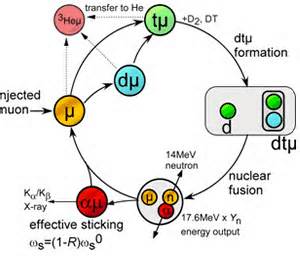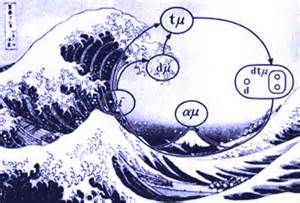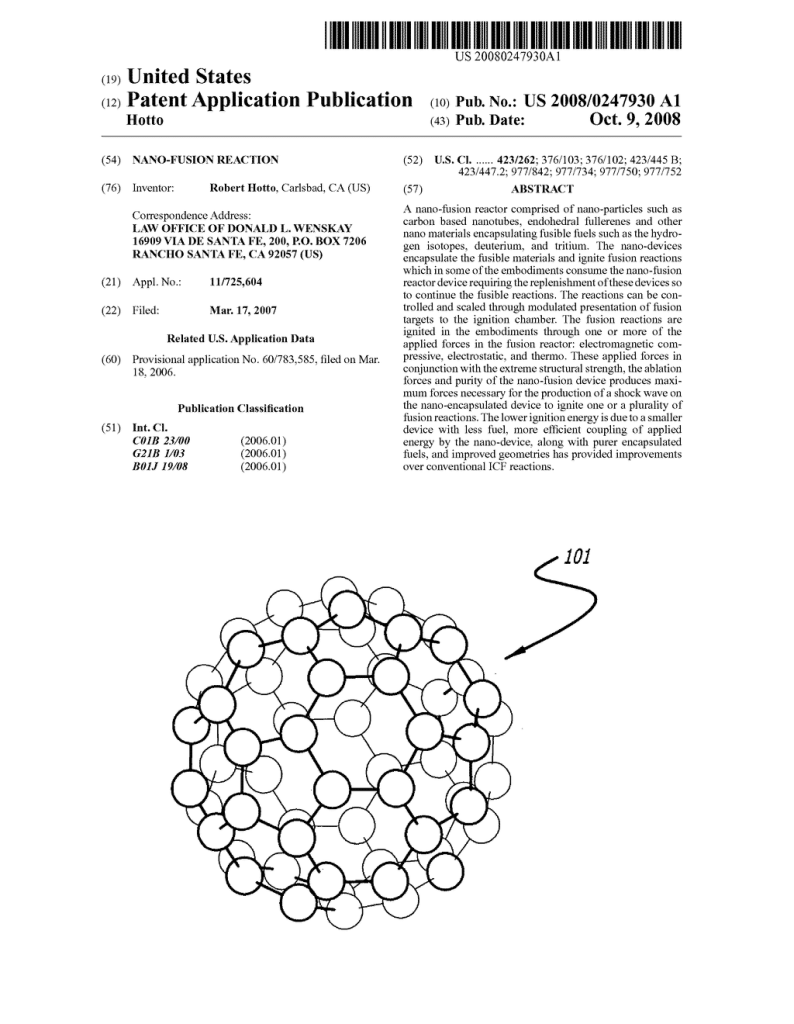The More Sinister Directions Of Carbon Nanotubes (as weapons of war)
By Dr. Richard Alan Miller, © 2014
With the possibilities of fullerenes being able to act as a super anti-oxidant (radiation sickness), and a space elevator, it also opens other door to the possibility of weapon of war. Here is where my latest Internet research has led. I begin with some definitions in the physics involved
The Neutron Bomb – A neutron bomb (Enhanced Radiation Weapon) is a low yield fission-fusion thermonuclear weapon (hydrogen bomb) in which the burst of neutrons generated by a fusion reaction is intentionally allowed to escape the weapon, rather than being absorbed by its other components
The weapon’s radiation case, usually made from relatively thick uranium, lead or steel in a standard bomb, are instead made of as thin a material as possible to facilitate the greatest escape of fusion produced neutrons
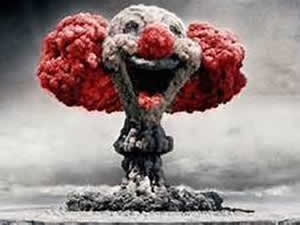 Compared to a pure fission bomb with an identical explosive yield, a neutron bomb would emit about ten time the amount of neutron radiation. Enhanced radiation weapons also fall into this same yield range and simply enhance the intensity and range of the neutron dose for a given yield
Compared to a pure fission bomb with an identical explosive yield, a neutron bomb would emit about ten time the amount of neutron radiation. Enhanced radiation weapons also fall into this same yield range and simply enhance the intensity and range of the neutron dose for a given yield
Pure Fusion Weapon – A pure fusion weapon is a hypothetical hydrogen bomb design that does not need a fission “primary” explosive to ignite the fusion of deuterium and tritium, two heavy isotopes of hydrogen
Such a weapon would require no fissile material and would therefore be much easier to build in secret than existing weapons. The necessity of separating high-quality fissile material requires a substantial industrial investment (making plutonium), and blocking the sale and transfer of the needed machinery has been the primary mechanism to control nuclear proliferation to date
For many years, nuclear weapon designers have researched whether it is possible to create high enough temperatures and pressures inside a confined space to fuse together deuterium and tritium for the purposes of developing such a weapon
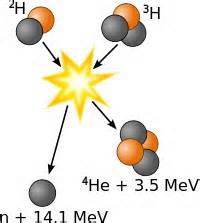 Pure fusion weapons offer the possibility of generating very small nuclear yields and the advantage of reduced collateral damage stemming from fallout because these weapons would not create the highly radioactive byproducts associated with fission-type weapons
Pure fusion weapons offer the possibility of generating very small nuclear yields and the advantage of reduced collateral damage stemming from fallout because these weapons would not create the highly radioactive byproducts associated with fission-type weapons
Nano- Fusion Reaction – The most difficult aspect of hydrogen fusion is overcoming the electrostatic forces that cause the hydrogen nuclei to repel each other. So a question is asked: Would it be possible to place one of the nuclei inside some conducting sphere like a Buckminsterfullerene so that the fullerene acts as a Faraday cage?
The fullerene would have an induced negative charge on the inner surface, and an induced positive charge on the outer surface. When the second nucleus is brought nearby, the positive charge on the outer surface will accumulate on the side of the cage further away, and some negative charge would accumulate on the side closer to the outside positive charge
Would this setup effectively weaken the strength of the electric field that either one of the nuclei encounters? You don’t even need to construct a shell. Drop an electron on orbit with a proton, and you get a hydrogen atom. That electron shell already neutralizes the proton’s charge. That is why you can stick two hydrogen atoms together
The problem is the size difference. P rotons are on the order of femtometer. Hydrogen atom is on the order of an angstrom. That’s 10,000 times too big. And the reason for that is electron’s mass. They are just too light. What you need is a particle with similar properties, but significantly heavier. And we now have one
The trouble is, a muon has a very short half-life, and are difficult to produce in high quantities without high energy losses. If we could find a way to produce a muon at near 100% efficiency, we could easily have cold fusion.
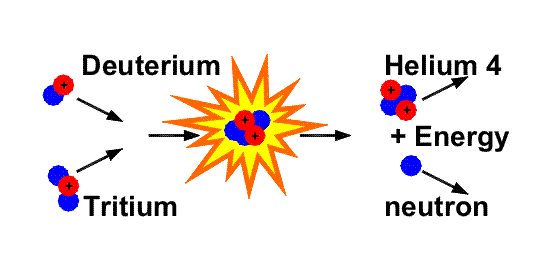 These weapons would be lethal not only because of their explosive force, which could be large compared to bombs based on chemical explosives, but also because of the neutrons they generate. The neutrons may cause substantially more casualties than the explosive blast, as in a neutron bomb
These weapons would be lethal not only because of their explosive force, which could be large compared to bombs based on chemical explosives, but also because of the neutrons they generate. The neutrons may cause substantially more casualties than the explosive blast, as in a neutron bomb
Muon-catalyzed fusion (?CF) is a process allowing nuclear fusion to take place at temperatures significantly lower than the temperatures required for thermonuclear fusion, even at room temperature or lower. It is one of the few known ways of catalyzing nuclear fusion reactions.
Muons are unstable subatomic particles. They are similar to electrons, but are about 207 times more massive. If a muon replaces one of the electrons in a hydrogen molecule, the nuclei are consequently drawn 20 times closer together than in a normal molecule. When the nuclei are this close together, the probability of nuclear fusion is greatly increased, to the point where a significant number of fusion events can happen at room temperature.
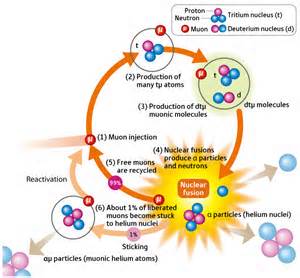 Current techniques for creating large numbers of muons require large amounts of energy, larger than the amounts produced by the catalyzed nuclear fusion reactions. This prevents it from becoming a practical power source
Current techniques for creating large numbers of muons require large amounts of energy, larger than the amounts produced by the catalyzed nuclear fusion reactions. This prevents it from becoming a practical power source
Moreover, each muon has about a 1% chance of “sticking” to the alpha particle produced by the nuclear fusion of a deuterium with a tritium, removing the “stuck” muon from the catalytic cycle, meaning that each muon can only catalyze at most a few hundred deuterium tritium nuclear fusion reactions
So, these two factors, of muons being too expensive to make and then sticking too easily to alpha particles, limit muon-catalyzed fusion to a laboratory curiosity. To create useful room-temperature muon-catalyzed fusion reactors would need a cheaper, more efficient muon source and/or a way for each individual muon to catalyze many more fusion reactions.
Muon-catalyzed fusion is a well established and understood fusion mechanism. Although it is also a relatively low temperature process, it is distinct from cold fusion.
Abstract: A nano-fusion reactor comprised of nano-particles such as carbon based nanotubes, endohedral fullerenes and other nano materials encapsulating fusible fuels such as the hydrogen isotopes, deuterium, and tritium. The nano-devices encapsulate the fusible materials and ignite fusion reactions which in some of the embodiments consume the nano-fusion reactor device requiring the replenishment of these devices so to continue the fusible reactions. The reactions can be controlled and scaled through modulated presentation of fusion targets to the ignition chamber. The fusion reactions are ignited in the embodiments through one or more of the applied forces in the fusion reactor: electromagnetic compressive, electrostatic, and thermo. These applied forces in conjunction with the extreme structural strength, the ablation forces and purity of the nano-fusion device produces maximum forces necessary for the production of a shock wave on the nano-encapsulated device to ignite one or a plurality of fusion reactions. The lower ignition energy is due to a smaller device with less fuel, more efficient coupling of applied energy by the nano-device, along with purer encapsulated fuels, and improved geometries has provided improvements over conventional ICF reactions. …

